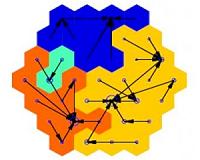| . |  |
. |
Bloomington, IN (SPX) Jan 27, 2011 Can't help molding some snow into a ball and hurling it or tossing a stone as far into a lake as you can? New research from Indiana University and the University of Wyoming shows how humans, unlike any other species on Earth, readily learn to throw long distances. This research also suggests that this unique evolutionary trait is entangled with language development in a way critical to our very existence. The study, appearing online in the journal "Evolution and Human Behavior," suggests that the well-established size-weight illusion, where a person who is holding two objects of equal weight will consider the larger object to be much lighter, is more than just curious or interesting, but a necessary precursor to humans' ability to learn to throw - and to throw far. Just as young children unknowingly experience certain perceptual auditory biases that help prepare them for language development, the researchers assert that the size-weight illusion primes children to learn to throw. It unwittingly gives them an edge - helping them choose an object of size and weight most effective for throwing. "These days we celebrate our unique throwing abilities on the football or baseball field or basketball court, but these abilities are a large part of what made us successful as a species," said Geoffrey Bingham, professor in IU's Department of Psychological and Brain Sciences. "It was not just language. It was language and throwing that led to the survival of Homo sapiens, and we are now beginning to gain some understanding of how these abilities are rapidly acquired by members of our species." Why is throwing so important from an evolutionary standpoint? Bingham said Homo sapiens have been so successful as a species because of three factors: Social organization and cooperation, language, which helps with the former factor, and the ability to throw long distance. This trio allowed Homo sapiens to "take down all the potential competition," Bingham said. It brought us through the ice ages because Homo sapiens could hunt the only major food sources available, big game such as mammoths and giant sloths. Bingham and Qin Zhu, lead author of the study and assistant professor at the University of Wyoming, Laramie, consider throwing and language in concert, because both require extremely well-coordinated timing and motor skills, which are facilitated by two uniquely developed brain structures - the cerebellum and posterior parietal cortex. "The idea here is that our speech and throwing capabilities came as a package," said Bingham, director of the Perception/Action Lab at IU. Language is special, and we acquire it very rapidly when young. Recent theories and evidence suggest that perceptual biases in auditory perception channel auditory development, so that we become attuned to the relevant acoustic units for speech. Our work on the size-weight illusion is now suggesting that a similar bias exists in object perception that corresponds to human readiness to acquire throwing skills." Bingham and Zhu, who completed his doctorate in the Department of Kinesiology at IU's School of Health, Physical Education and Recreation, put their theory to the test, recruiting 12 adult men and women to perform various tests related to perception, the size-weight illusion and throwing prowess. Another way of stating the size-weight illusion is that for someone to perceive that two objects - one larger than the other - weigh the same, the larger object must weigh significantly more than the smaller object. Their study findings show that skilled throwers use this illusion of 'equal felt' heaviness to select objects that they are able to throw to the farthest, maximum distance. This, says Bingham, suggests the phenomenon is not actually an illusion but instead a "highly useful and accurate perception." Neanderthals, which co-existed with Homo sapiens long ago, lacked the more developed cerebellum and posterior parietal cortex. "These brain structures have recently been found to distinguish Homo sapiens from Neanderthals," Bingham said. "It is possible that this is what enabled us to beat out Neanderthals, who otherwise had the larger brains."
Share This Article With Planet Earth
Related Links Indiana University All About Human Beings and How We Got To Be Here
 Mathematical Model Explains How Complex Societies Emerge And Collapse
Mathematical Model Explains How Complex Societies Emerge And CollapseBethesda MD (SPX) Jan 21, 2011 The instability of large, complex societies is a predictable phenomenon, according to a new mathematical model that explores the emergence of early human societies via warfare. Capturing hundreds of years of human history, the model reveals the dynamical nature of societies, which can be difficult to uncover in archaeological data. The research, led Sergey Gavrilets, associate director for ... read more |
|
| The content herein, unless otherwise known to be public domain, are Copyright 1995-2010 - SpaceDaily. AFP and UPI Wire Stories are copyright Agence France-Presse and United Press International. ESA Portal Reports are copyright European Space Agency. All NASA sourced material is public domain. Additional copyrights may apply in whole or part to other bona fide parties. Advertising does not imply endorsement,agreement or approval of any opinions, statements or information provided by SpaceDaily on any Web page published or hosted by SpaceDaily. Privacy Statement |